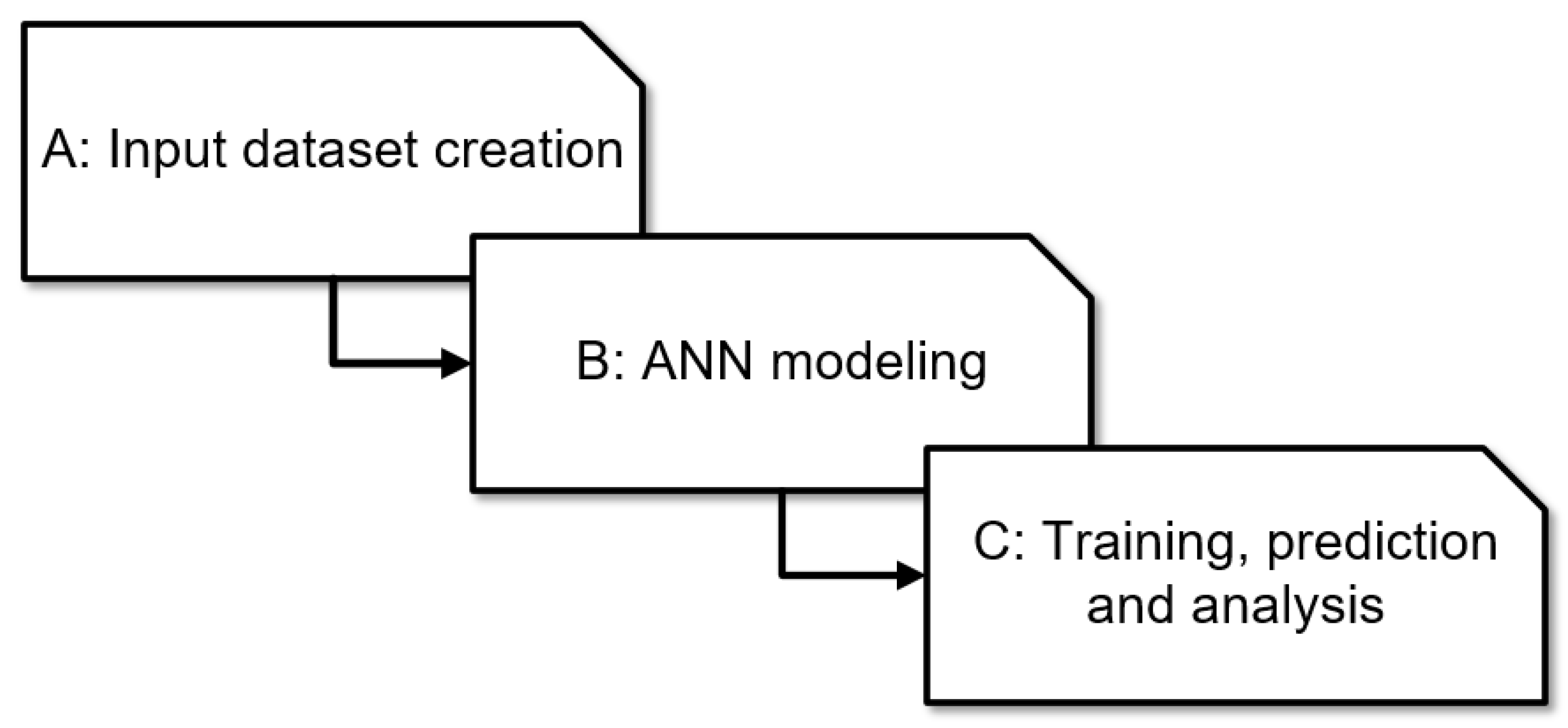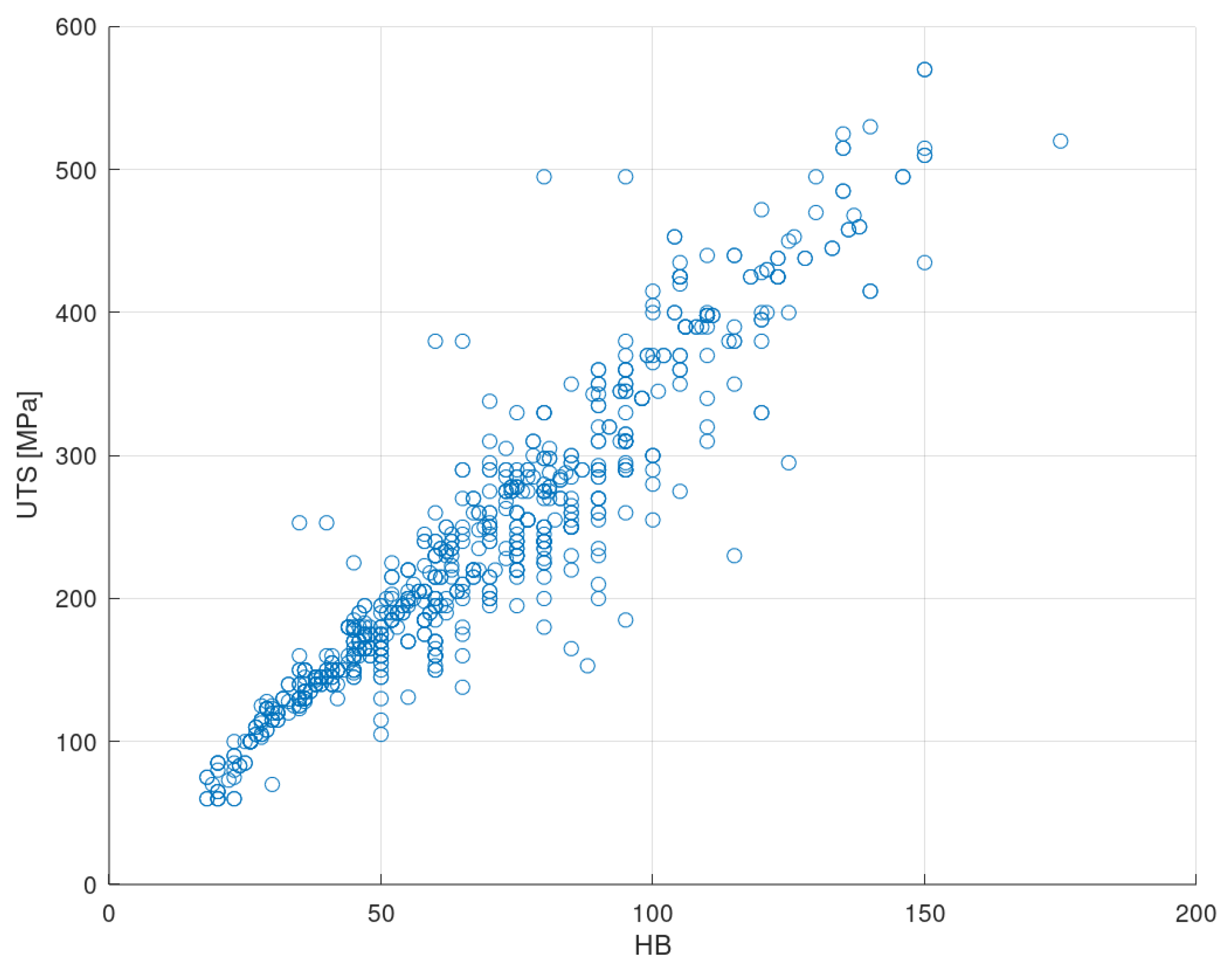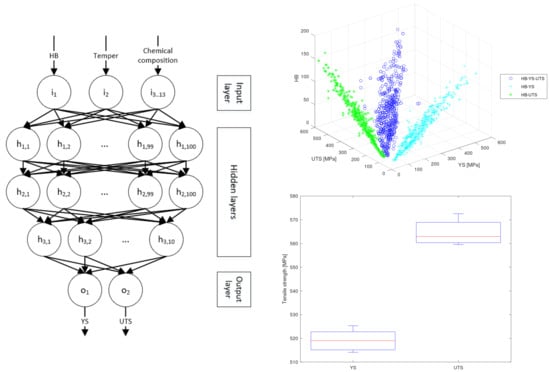In metal forming, the plastic behavior of metallic alloys is directly related to their formability, that is the material’s ability to undergo plastic deformation. In fact, for the study of forming processes, the plastic behavior of metals is typically implemented in finite element simulation [
1,
2] and other analytical methods [
3] by the so-called flow curves. In engineering applications, the plastic behavior has been traditionally characterized by simplified models; apart from well-known models such as Hollomon’s power law and the Swift model [
4], a linear approximation is the easiest way to model the plastic behavior through the mechanical properties’ yield strength (YS) and ultimate tensile strength (UTS), especially when strain hardening has an important role such as in cold forming conditions.
1.1. Aluminum Alloys
Aluminum alloys have one of the lowest densities among structural metals, high resistance to corrosion, high strength (even higher than some steels), and good electrical and thermal conductivity [
5]. On the other hand, they have an excellent workability and machinability and allow a large number of surface finishes [
5]. Aluminum is a ductile and malleable material that can be shaped using a wide variety of techniques; however, its alloys have very different properties that significantly affect its forming behavior [
6,
7].
Pure aluminum (1100-O) is a relatively soft material [
5]; however, its alloys exhibit an enormous variety of resistance and ductility values, which make it an exceptional material. The main alloying elements of aluminum are copper, magnesium, silicon, manganese, nickel, and zinc [
8]. The relatively low hardness of aluminum can sometimes cause abrasive wear of the material [
9]. The low hardness of pure aluminum makes it a non-ideal material for building structures. For this application, alloying elements must be added to make it stronger [
10]. These supplementary elements do not simply improve the hardness of the metal, but also modify other properties [
11,
12]. Besides, heat-treated aluminum alloys can withstand more load due to the precipitation hardening process of aluminum, even though the hardness is different due to the addition of various alloying agents [
9].
Nondestructive approaches to approximate the yield strength (YS) and the ultimate tensile strength (UTS) have been often of interest to engineers [
5] because mechanical data can be collected quickly without requiring samples for testing [
13]. One very relevant technique to estimate these tensile properties has been the hardness test because it is almost nondestructive (leaving behind only a small indentation) [
14]. Moreover, there are techniques that, in the industrial environment, are considered as totally non-destructive, such as the ultrasonic contact impedance hardness test [
15,
16].
The methodological approach presented in this paper has the advantage of allowing the yield stress and the ultimate tensile strength to be estimated based on known values (chemical requirements specified by standards [
17] and heat treatments, both typically accessible in databases) and an almost non-destructive test (hardness test). Using traditional techniques, these two properties can only be obtained by conducting tensile tests (destructive) that require specimens and access to facilities and other resources such as equipment. On the other hand, characterizing the mechanical resistance of the material together with a good design improve the safety level.
There is a wide variety of decision support systems focused on materials engineering [
18]; however, very few really take advantage of technologies based on artificial intelligence [
9,
10,
19,
20,
21,
22]. Although several studies that use machine learning to address metallotechnics and the properties of metals have been published [
23,
24], aluminum alloys have hardly been investigated considering their tempers from an industrial perspective using these tools [
25].
In this study, a computer-aided methodology is developed to predict some fundamental properties of aluminum alloys whose chemical composition and treatments (thermal and mechanical) are known [
10]. The system presented in this work is able to predict accurately the yield stress (YS) and the ultimate tensile strength (UTS) of aluminum alloys based on Brinell hardness data [
9,
26]. This methodology uses artificial neural networks (ANNs) and technology based on machine learning to carry out the predictions.
1.2. Brinell Hardness and Material Strength
The Brinell hardness scale, proposed in 1900, is an indentation hardness measurement scale in which the penetration of a spherical ball into the test material is measured [
27]. This indenter, when subjected to a standard load, deforms the material, creating a spherical cap, whose diameter is used to calculate the Brinell hardness [
28,
29]. The Brinell (HB) and Vickers (HV) hardness scales are among the most widely used, and in the case of aluminum alloys, their values are equivalent [
30,
31]. Aluminum alloys have hardness values ranging from HB∼20 to HB∼200 [
32].
These two scales are based on the measurement of the plastic deformation that occurs on a material when applying a standard load through a standard penetrator [
28,
29]. Therefore, the mechanical process is closely related to the properties that define the plastic deformation of a material [
31], namely the YS and the UTS. In the development of the indentation that occurs during the Brinell hardness test, the main mechanical process that takes place is the plastic flow of the metal around the indenter [
11].
The relationship between the hardness of a material and their tensile properties is so intimate that mathematical expressions have been proposed; however, these equations are not universal [
33]. Both the YS and the UTS of steels and aluminums exhibit a correlation with the hardness over the entire range of strength values, and so, empirical relationships can be provided that enable the estimation of strength from a bulk hardness measurement if a certain error is allowed [
34,
35,
36,
37].
A good understanding of the correlation between the tensile properties and the hardness of materials is very noteworthy [
38]:
Reliable hardness strength relationships allow for quick mechanical property evaluations by means of fast and low-cost hardness testing instead of complicated tensile testing.
Contrary to tensile tests, the hardness can be measured non-destructively in situ on fully assembled devices, therefore allowing for structural integrity tests in service.
Often, new materials could only be manufactured at a small scale; these materials are not sufficient to accomplish extensive tensile testing, and so, hardness testing is frequently the only option.
There has been a great interest in trying to find approximations to the tensile properties from the results of the hardness tests. These efforts can be grouped as follow:
Estimation of the tensile properties directly from the results of hardness tests [
13,
14,
35,
38,
39,
40].
Estimation of the tensile properties indirectly from a material constant obtained from the results of hardness tests [
13,
14,
38].
In this study, a third new method is going to be developed, similar to the first one, but with the particularity that the function that relates the tensile properties with Brinell hardness will be obtained using artificial intelligence and machine learning [
41]. This new methodology takes, as input, the chemical composition, the temper, and the Brinell hardness and, then, approximates the yield strength and the ultimate tensile strength [
9,
10].
This new approach will be compared with the equations that directly estimate the tensile properties from the Brinell hardness test values. The literature is consistent in reflecting a linear relationship between the yield strength and the result of the Brinell hardness test (see Equation (
1)) [
13,
14,
38,
40].
where
is the yield strength,
is the Brinell hardness, and
and
are coefficients related to the material that are strongly affected by the tempers. For aluminum alloys,
[
13,
14,
38].
Estimating the UTS from hardness data has been mostly experimental because the phenomenon of tensile instability after which engineering strain increases while engineering stress falls does not take place during indentation [
14]. However, it is common to find linear approximations with slopes close to three (see Equation (
2)) [
38,
42,
43].
where
is the ultimate tensile strength and
is the Brinell hardness.
In the case of UTS, a linear expression similar to the yield stress approximation is proposed. In this case, the y-intersection coefficient
is positive (see Equation (
3)) [
14]:
where
is the ultimate tensile strength,
is the Brinell hardness, and
and
are coefficients related to the material.
Although estimating tensile properties from hardness data has been seen as a very practical method, some persistent discrepancies between theoretical models and best-fit equations resulting from empirical data have to be resolved [
40]. Only the equations that have been developed for a precise alloy are able to make good predictions at the cost of being too specific. In general, the literature focuses its efforts on specific materials or on certain types of alloys [
44]. It is not common to find studies that contain general expressions that are valid for all aluminum alloys, except those that require obtaining empirical coefficients that are employed to fit the equations [
35,
39].
1.3. Artificial Neural Networks
Since its inception [
45], artificial intelligence (AI) has shown that it can be applied to a wide spectrum of disciplines not directly related to computing. Among the most significant new uses, medicine [
46,
47], warfare [
48], ecology [
49], security [
50], education [
51], oil exploration [
52], or material science [
44,
53] can be emphasized. Today, ANNs have become one of the most notable AI methods due to their incredible accomplishments and unstoppable advancement [
10,
54].
An ANN is a mathematical model inspired by the biological behavior of neurons and the structure of the brain [
41,
55]. In a multi-layer neural network, perceptrons, the basic units that form an ANN, are hierarchically organized into layers [
54]. A layer is a set of neurons not connected to themselves nor to each other that receive their input data from the same source (the outside or another layer) and that send their information to the same destination (another layer or the outside) [
41].
Therefore, three types of layers can be distinguished: the input layer, which receives information from the outside; the hidden layers are those whose inputs and outputs are within the system and, therefore, have no contact with the outside; and finally, the output layer, which sends the response from the network to the outside [
9,
10]. Many different topological models can be defined depending on the organization of the perceptrons and the type of connections they establish between them [
41,
54].
A multilayer ANN is a supervised learning algorithm capable of learning a nonlinear function by training on a labeled input dataset that can be used to perform classifications and regressions [
41,
54,
56] and that can overcome traditional programming in some tasks. However, neural systems are not without certain drawbacks. One of the most important is that they usually carry out such complex processing that involves thousands of operations, so it is not possible to follow, step by step, the reasoning that led them to draw their conclusions [
41,
57]. Nevertheless, in small networks, by simulation or by studying synaptic weights, it is possible to know, at least, which input variables have been relevant in decision-making [
58,
59,
60].
Various artificial intelligence techniques have been implemented in the material science field to carry out different types of analysis or predictions about the properties and behavior of industrial components and materials [
20,
22]: prediction of elastic properties of metals [
10,
61], prediction of metallic components behavior [
19,
62,
63,
64], optimization of alloy composition [
25,
65], or early prediction of the degradation of metallic materials [
53,
66]. As already stated, artificial intelligence and neural networks can be applied to almost all science fields [
57,
67].
The main objective of this work is to develop an ANN capable of making precise predictions about two of the main tensile properties of commercial aluminum alloys. Therefore, it must be ensured that the predictive error is small and that all the information obtained throughout the training and prediction phases is analyzed to obtain statistical metrics about the performance of the methodology.
























